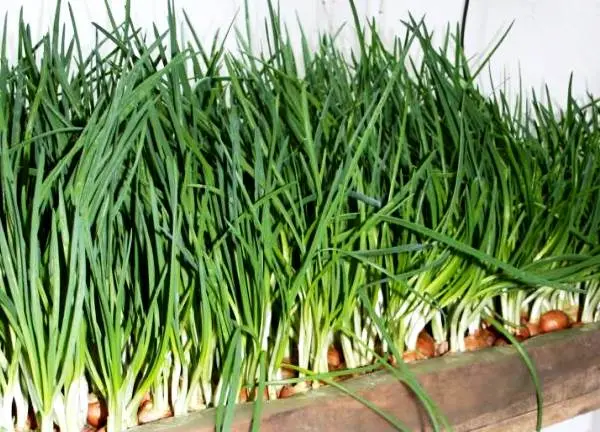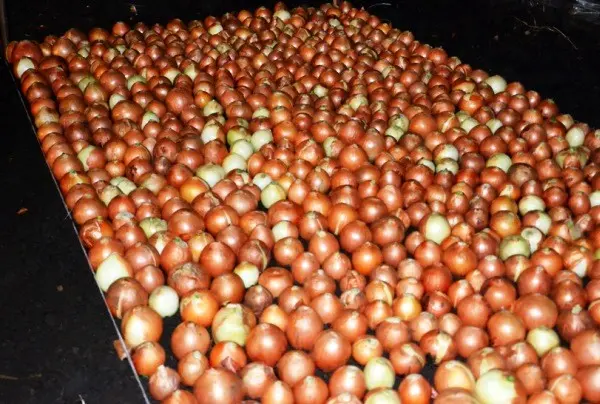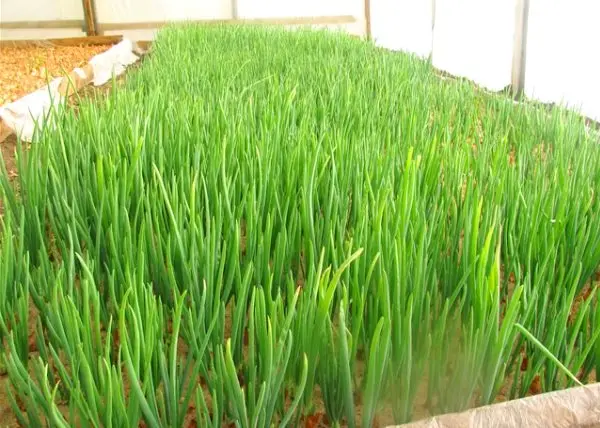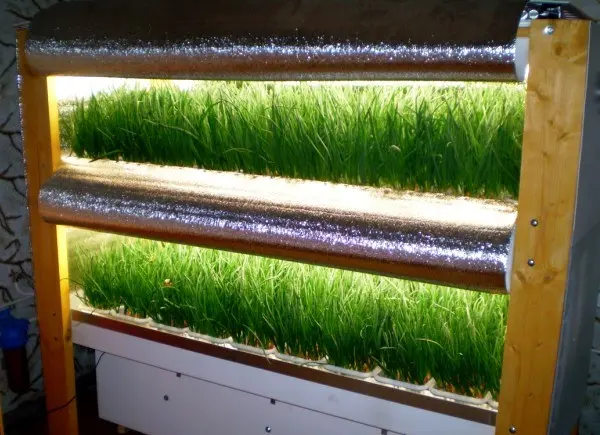What do we miss the most in winter in the body? That’s right, vitamins. To do this, we try to constantly eat vegetables and fruits. But it is not necessary to buy them in stores, because some vegetables can be grown at home, for example, greens. Forcing onions on a feather is a very popular option for growing vegetables, which is easy to do even in a city apartment. In addition to the fact that green onions contain many useful substances, their use in various dishes also gives a special charm and taste. The technology for forcing onions on a feather is not complicated, and with the help of this article we will help you figure it out.
The main rules of cultivation
Onion forcing on a feather can be carried out at any time of the year, because it is not difficult to create suitable conditions. The growth of green onions is largely dependent on the nutrients supplied to the bulbs, so there is virtually no difference where to grow onions – in a greenhouse, nurseries or insulated beds. But still there is one caveat – adhere to the methods of proper agricultural technology and fulfill all the requirements regarding the conditions for the growth and development of the plant. Not only will you be able to harvest a high yield of quality green onions, but these methods will help shorten the onion forcing to feather.

First of all, you need to choose the right variety, because not everyone is well suited for distillation, in some the underground part develops much faster. These are multi-primary species, up to five leaves can form from each primordium, respectively, and more greenery will turn out. The Soviet varieties Strigunovsky, Rostovsky, Spassky were very popular at one time, now they also grow Amber, Black Prince. They were planted at the end of October. Closer to winter, Arzamas, Soyuz, Bessonovsky are planted, it is good to grow Sprint and Siberian yellow at home. Most likely you will have to deal with modern varieties, since Soviet ones are very problematic these days. In addition to varieties, attention should also be paid to species: leeks, shallots, batun, multi-tiered, slime onions are best suited for forcing on a feather. Each of them is endowed with distinctive properties and characteristics, has its own advantages, so make a more detailed choice based on personal preferences.
You can grow onions on a feather in a greenhouse or in open ground. They are planted in open soil either in autumn, about two weeks before frost, or in early spring, immediately after the snow melts. It is advisable to lightly prepare the bulbs before planting: soak in warm water for about a day, and just before planting in the ground, slightly cut the top. Thanks to such ingenuous measures, the forcing will occur faster, and the yield will increase significantly.

Forcing onions on a feather in the garden is carried out in two ways: bridge and tape. In the first case, the bulbs are placed close to each other, so about 1 kg of vegetables will be needed per 10 square meter. Sprinkle on top of the earth with a large layer of earth. The tape method involves placing the bulbs in the grooves at a distance of two to three centimeters, the distance between the rows is 10-15 cm. If the whole thing happens in the fall, then the seedlings should additionally be “covered” with a layer of manure or humus five centimeters thick.
Also in open ground, you can grow onions on a feather and from seeds. This method is rarely used, it attracts gardeners only for its cheapness (the cost of seeds is much lower than turnips), but it requires a significant amount of time – you need to sow in July, and you will receive a harvest only in the spring. In addition to the usual care activities (soil preparation, fertilizing, watering), mulching is also added (as a rule, straw is used, it is very good if there is peat). It is clear that for a good harvest, only high-quality bulbs should be used, but some gardeners separately plant old, small or rotten specimens, because they will still have to be thrown away, and this will make another small contribution to the main crop.

In the greenhouse, you can grow onions on a feather all year round. Only the bridge method is used. The soil should contain as many nutrients as possible, so feel free to add manure, humus, peat, fertilizers (but only mineral fertilizers, any chemical preparations are strictly contraindicated!). Additionally, you can treat the soil with wood ash.
As with planting in open ground, first soak the bulbs in warm water for a day and cut the tops, but it is not necessary to sprinkle with earth in the greenhouse. It is best to plant in separate boxes, it is much more convenient and easier. Care is not complicated – periodic watering, fertilizing a couple of times, monitor the air temperature (it is undesirable that it drops below 20 degrees, do not allow drafts). Watch closely so that the plants do not get sick, immediately remove the infected until the entire plantation has died. It is recommended to collect the feather after it reaches a length of 25-35 cm, depending on the variety.

Forcing in hydroponics
Forcing onions hydroponically is a convenient way to have greens for your own use and for sale almost all year round. This method allows you to harvest green onions in a very short time. First of all, you should also decide on the variety. You can use the same as for open ground, there is not much difference. Not without prior preparation. As in the previous method, you can simply cut the top of the bulb, you can make two shallow (about a third) cuts crosswise. In the second case, you need to give the incised fruits a little time to “heal wounds”, placing them in the shade for a couple of days, but then the feather will grow at an accelerated pace. There is another way to speed up germination – soak for at least 10 hours in warm water, adding a little wood ash.
The next step is to prepare the necessary equipment, there are special plates for hydroponics, mats are widely used. You will also need special liquid fertilizers, which can be easily purchased at various specialized stores. It is worth planting onions only in a moist substrate so that it can immediately receive nutrients.
If you are planting bulbs that have already begun to grow feathers, then give them more free space: there should be the same distance between rows and bulbs in a row – 2-3 cm. Experienced gardeners also recommend sprinkling with vermiculite.

The first week “plantation” should be kept in a cool and dark place. During this time, the root system will have time to develop, which will become the key to the successful growth of the pen. Further, on the contrary, plants need a lot of light for the growth of greenery. Therefore, take care of the light sources in advance. This is especially true in winter, when daylight hours are very short, so the use of lamps is inevitable to achieve a high yield. But in addition to lamps, you will also have to use devices to increase the temperature, it must always be at least 25 degrees. This will also accelerate the growth of the feather, and in two weeks it will be able to reach a length of up to 30 cm.
Most gardeners agree that forcing onions into a feather is more profitable with hydroponics, especially if you build your business on it. A huge advantage – thanks to the ability to grow in the winter, while not spending extra effort. But it doesn’t matter for what purpose you will grow green onions, the main thing is that this activity gives you pleasure, and to have some benefit from it is another pleasure. We hope that our advice was not in vain and will be useful to you in the future.
Video “Forcing onions on a feather”
This video highlights the preparation of onions for planting in sawdust for forcing on a feather. Lettuce turnip.









